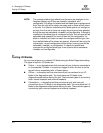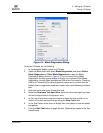
5 – Managing I/O Blades
Testing I/O Blades
5-8 59234-03 A
S
5.4
Testing I/O Blades
You can test all ports on a selected I/O blade using the Blade Diagnostics dialog.
The types of tests for I/O blades are:
Online — a non-disruptive test that exercises all port-to-device connections
on the selected I/O blade. If no ports are logged in when the test is run the
test will return immediately with a Passed status.
Offline — a disruptive test that exercises all port connections for an I/O
blade in the diagnostics state. You must place the I/O blade in the
diagnostics state before starting the test. There are two types of connectivity
tests: internal loopback and external loopback.
Connectivity — a disruptive test that exercises all port and inter-port
connections for an I/O blade in the diagnostics state. You must place the I/O
blade in the diagnostics state before starting the test. There are two types of
connectivity tests: internal loopback and external loopback.
NOTE: The configured blade type affects how the ports are displayed in the
faceplate display and if they are viewable, selectable, and
configurable. If no blade is installed and the blade type is configured as
Auto, then the slot will be shown as empty and no ports will be shown
in the slot. If no blade is installed and the blade type is not configured
as Auto, then the slot is shown as empty, the ports are shown ghosted,
but all the ports are selectable, viewable, and configurable. If a blade is
installed and the blade type is configured as Auto, then all ports will be
selectable and viewable, but none of them will be configurable. If a
blade is installed, but does not match the configured blade type, then
the installed blade will be shown as downed, all ports will be set to the
critical state, no port configuration will be shown, and no ports will be
selectable, viewable, or configurable. If a blade is installed and
matches the configured blade type, then all ports will be selectable,
viewable, and configurable.


















